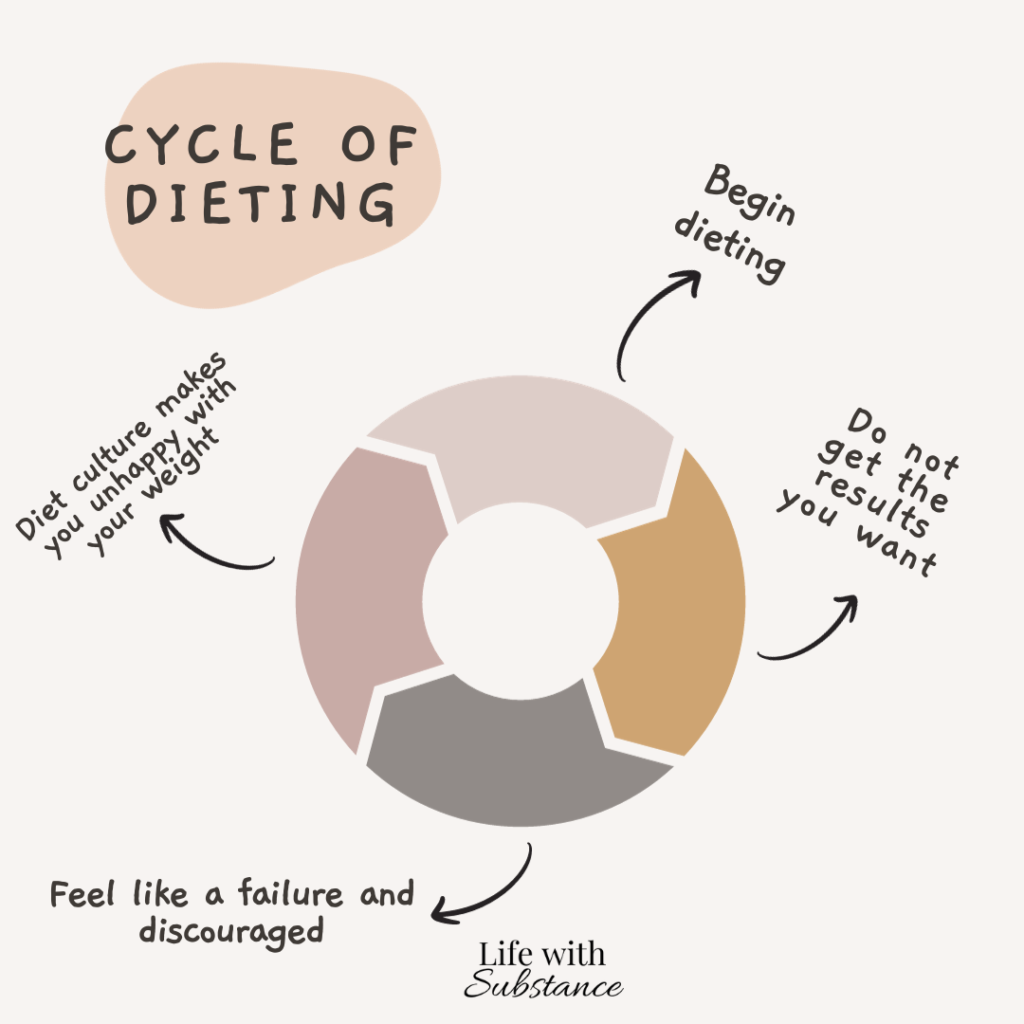This post may contain affiliate links. If you shop from one of our links, we may earn a commission.
Broccoli is good but brownies are bad. Carbs are fattening but protein builds muscle. Processed foods are toxic but fresh produce is clean. Long ingredient lists are bad but ingredients you can pronounce are safe. Eat this, not that screams the diet culture world. So how are we as parents supposed to teach our kids about living a healthy lifestyle when we are bombarded by so many conflicting messages? The secret sauce is in modeling food neutrality.
The Problem with Diet Culture
I think it’s safe to say that most parents desire for their kids to have a positive relationship with their bodies and eat a variety of foods. Unfortunately, diet culture gets in the way of how we should talk to our kids about nutrition and their bodies. Diet culture is a set of social expectations that we should eat and look a specific way to be considered healthy. Food neutrality, on the other hand, states that food has no moral value.
Diet culture acts as the food and body police yelling that we are never good enough. It sends messages that the only way to happiness is through thinness. Many of us grew up hearing these messages which may have led to restrictive diets, disordered eating, or even an eating disorder. It can take years to make the mental shift away from diet culture to body acceptance. Maybe you are still stuck in the cycle and have been unaware of the effects of diet culture. Now that you are aware of it, you will find it is being preached everywhere. From billboards to magazines to social media to commercials. It’s hard to avoid it’s presence.
Despite the loud messages, thinness and health are not the same, nor does being overweight equate to being unhealthy.
How Diet Culture Affects Kids
Unfortunately, our kids aren’t exempt from diet culture. They are constantly going to hear messages about foods being “good” or “bad” from either their peers, teachers, or other parents. I know for my kids, the school frequently sends messages to parents to encourage them to “only send healthy foods”. Even my kids have been told by teachers they can’t eat their dessert at school because it “isn’t healthy”. Hearing such messages quickly creates a sense of shame and guilt for choosing these items. It’s important for us as parents to help them identify these messages to prevent feelings of guilt for their food choices.
Unfortunately, we are seeing kids become more fixated on their physical appearance and looking to diets to help. Studies show:
- 42% of 1st-3rd grade girls are unhappy with their body and desire to be thinner
- 81% of 10-year-old children are worried about being overweight
- 46% of 9-11 year-olds are “sometimes” or “very often” on diets
- 35-57% of adolescent girls participate in crash dieting, fasting, self-induced vomiting, diet pills, or laxatives.
Sadly, even young kids are picking up on these messages and internalizing the messages they hear. What’s worse is that they are choosing to act on these messages. While it may feel like a more neutral approach to not talk about diet culture messages, simply NOT talking about it is actually worse. As parents, we need to help them recognize these negative messages and know how to respond in a healthy manner.
Thankfully there are things we can do to help free ourselves and our children from the negative comments that promote an unhealthy relationship with food and body.

What is Food Neutrality
Food neutrality uses language and behavior to promote a neutral perspective on all foods. This doesn’t mean that foods don’t contain good or bad qualities. Yes, an apple has more nutritional benefits than a brownie. Instead, it removes the language that creates a charged association with food to prevent the sense of judgment for the foods you or others choose to consume. Food neutrality means that all foods, regardless of their nutrition profile, have the same moral value.
Health Goals for Kids
At the end of the day, most parents want their kids to:
- Enjoy a variety of foods
- Eat in response to their internal cues of hunger and fullness
- Enjoy treats without feelings of guilt or shame
- Grow into the body that is right for them
- Not attach their worth to their weight
- Recognize that food can nourish the body in more ways than one
All these goals can be undermined when we begin labeling foods as “unhealthy”, “toxic”, “bad”, etc. When we label foods we create confusing messages for kids about food and their body. We can instill a sense of guilt or shame for eating a certain way. In turn, this can lead to further complications such as picky eating behaviors, hiding or sneaking food, restrictive eating, or emotional eating.

Your Relationship with Food and Body Matters
You may be reading this thinking, “How do I help my child have a healthy relationship with food and their body when I don’t even have that.” Maybe diet culture messages have left you feeling unhappy with your appearance and eating habits. Let me tell you that you’re not alone in feeling this way, and MANY other parents are going through these same struggles. These conversations with your child may feel very difficult and unnatural for you. However, there is a correlation between the parent’s relationship with food and their body and their child’s relationship with both. The good news is that you have an incredible opportunity to stop this cycle and create new messages for your child (and yourself).
Principles of Food Neutrality
Food neutral language consists of 3 principles:
- All foods provide some nutritional benefits.
- Yes, that brownie that yells “unhealthy” still provides you with carbohydrates and some protein.
- Yes, that brownie that yells “unhealthy” still provides you with carbohydrates and some protein.
- Food offers more than just nutrition.
- Food provides joy, comfort, memories, socialization, and so much more.
- Food provides joy, comfort, memories, socialization, and so much more.
- Health is multifaceted.
- The term health provides different meanings to different people. Health can mean something different to each person. What may be considered “healthy” for one person does not mean it is “healthy” for the next. Factors such as socio-economic status, genetics, stress, availability of food, and levels of privilege can all play a factor in what is considered health. For example, if a child in a low-income household only has the availability of “processed foods” that does not make them unhealthy. But the labels diet culture puts around these items send the message to the child that they should feel ashamed of their food choices.
- The term health provides different meanings to different people. Health can mean something different to each person. What may be considered “healthy” for one person does not mean it is “healthy” for the next. Factors such as socio-economic status, genetics, stress, availability of food, and levels of privilege can all play a factor in what is considered health. For example, if a child in a low-income household only has the availability of “processed foods” that does not make them unhealthy. But the labels diet culture puts around these items send the message to the child that they should feel ashamed of their food choices.

Food Neutrality Does Not Dismiss Nutrition
You might be thinking, “But Christine, shouldn’t we teach our kids about nutrition too.” I hear you! Yes, it is helpful to know how foods fuel our bodies. I am a pediatric dietitian after all so obviously I find value in promoting a healthy lifestyle. But quite honestly, these concepts can be quite complex for little ones. Teaching our kids nutrition lessons that specific colors of foods provide certain nutrients can be confusing and over their heads. If we tell our children that oranges have vitamin C to keep us from getting sick, they may think the only way to stay healthy is to eat that single food. This is another way that we label foods as either “healthy” or “unhealthy”.
Understanding the nutrition behind food can be helpful for you as a parent as you choose how to feed your family a variety of foods. But we don’t need to glorify certain foods with our kids. As parents, it is our job to understand how to provide our kids with a balanced diet that allows all types of foods to encourage healthy eating habits. No, that doesn’t mean that we should let our kids only eat treats.
The division of responsibility states that our role in feeding our children is to determine what foods to serve, when, and where. They determine whether they are going to eat and how much without guilt or shame for their food choices. This highly researched theory was developed by registered dietitian, Ellyn Satter, and has been proven to be an effective way to help families have a positive food relationship. Right now the focus should be on raising our kids to have a healthy relationship with food and body and become intuitive eaters by understanding hunger and fullness cues. You can learn more about intuitive eating here.
How to Change The Narrative
The good news is that we have an opportunity to change the narrative of the way we talk about food with our kids. A great time to start these conversations is when they are little. However, if you have older kids you can still change the narrative today to promote a healthier relationship with food and encourage body neutrality.
We can help our kids move past the fixation on the nutrition of foods and more on using their 5 senses. Talk to your kid about how the food tastes, smells, feels, looks, and how it sounds when eating it. Help your child learn descriptive words such as “crunchy”, “doughy”, “bitter”, “flakey”, etc. Tell your child what you are experiencing as you eat the foods as well to help them better understand these terms. For example, “carrots are so crunchy and make a snapping sound when you break them in half.”

Modeling Food and Body Neutrality
Kids are constantly observing our actions and the language we use about food and body image. One of the best ways we can educate our kids is by being a positive role model. Avoid using language around food and body that describes it as “good food”, “bad food”, “healthy”, “unhealthy”, “clean”, “processed”, and other diet culture terms. Label foods for what they are. For example, a brownie is a brownie. Not “full of sugar”, “fattening”, or “bad for you.”
You can also model this by allowing yourself to partake in enjoying these foods with your kids. Kids enjoy being able to sit and have a snack or meal together in a positive eating environment.
The same is true in how we talk about our body image. When we constantly are picking apart how we look we begin to set a standard for our kids of what is an acceptable body weight or shape. As we know, bodies change constantly as we grow and mature. We all go through various phases as we develop that can result in rapid growth or weight gain, which can be a very sensitive time for young children. Instead, you can promote body positivity by focusing on characteristics that go beyond appearance. Examples of compliments that are not directed toward body image include:
“You are so creative!”
“You are so kind.”
“I love spending time with you.”
“You’re such a good friend.”


How to Practice Food Neutrality Around Sweets
Diet culture has taught us that all sweets and treats (or “anything that tastes good”) are considered unhealthy. As I mentioned before, food neutrality does not dismiss nutrition. However, we can also help our kids know that food can have different roles. For example, food is fuel, but we also eat it because:
We enjoy it
Food provides pleasure
It can create memories
Instead of the narrative being around the negative effects of sweets and “junk food”, use language such as:
“Hot chocolate makes me think of playing outside on a snowy day.”
“I enjoy baking chocolate chip cookies because it reminds me of my grandma.”
“It’s fun to enjoy a brownie together after school.”
In Summary
Providing nutrition education for our kids can feel tricky in a diet culture world. However, teaching food and body neutrality can help your child be confident in their skin and food choices. We have the power to change the narrative, and the home is a great place to start.

